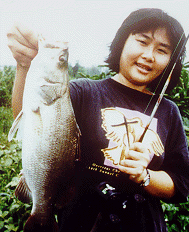



 Siakap
Siakap
a.k.a. Kakap Putih, Gelungsung, Barramundi, Giant Seaperch, Sea Bass. Siakap - Lates calcarifer Locally referred to as the Siakap on the west coast of Peninsula Malaysia or as Kakap Putih on the east coat of Peninsula Malaysia, this fish is also found elsewhere throughout Australasia and known as Barramundi, Giant Perch, or Sea Bass. The Siakap is an exciting sport fish and gives the angler thrills with its spectacular gill shaking aerial jumps! Upon hook up this fish will tear off and commence to leap out of the water to throw the hook. If the hook isn't embedded firmly, chances are the fish will get away scot free! Local haunts Generally an estuary fish, found in mangroves or at the river mouths to the sea, it also can be found further up river in freshwater. Catching it a few miles offshore is possible too. Like most fish it haunts structure like fallen trees, rock piles or depressions. Small channel runoffs into the main channel in the mangroves are favourite spots for the siakap to wait for food being washed into the main channel by the receding tide. The big siakap can also be found in the deep channels, waiting for tasty morsels to be swept in and out with the tides. The small siakap tend to school together. If one is caught, then subsequent casts will often produce several more siakap. The larger siakap tend to be loners. Luring the siakap Siakap are normally caught with bait like fresh prawns or fish. However, live prawns or fish make the best bait to catch this fish. Casting or trolling with lures is effective too. Any lure that looks like the local bait fish is found to be effective, but then lures that look nothing like natural food can be effective too. Different estuaries in Malaysia have different successful lures. It is best to check with the local anglers (if they will reveal the "secrets") or the local tackle shops. When targeting the big siakap, use lures that look like the mullet (belanak), 6-8 inches long. Soft plastic minnow shads or grubs can be very deadly, especially when fished next to cover, or in open water too. Flies like the seaducer, pink thing, whistler, clouser minnow, deceiver, poppers and dalhberg divers are enticing fly fishing lures for this fish. No teeth There are sharp spines on the fins of this fish, so care should be exercised when handling it. It has no teeth, so the best way of handling it is by gripping it at the lower jaw lip with the thumb and forefinger. The lips are like sand paper, so the use of wire is not necessary. Mono leader of 20-40lb is sufficient to withstand the abrasion of its sandpaper like lips. Sharp gill rakers are beneath the outer most gill covers, so it is possible for the mono leaders to be cut when the fish flares its gills and shakes its head. Nevertheless the use of wire leaders is not recommended as the fish tends not to hit bait or lures with wire leaders attached. Not many siakap are lost due to the mono leader being cut by the gill rakers as the angle has to be just right. Thus the mono leader is preferred. Fish farms The siakap is commonly stocked in the commercial saltwater angling ponds these days, giving the casual angler the opportunity to tangle with this great sportfish. The only draw back is that the fight is not as great as with a wild siakap, especially when the influence of the anaesthetic drugs used for transporting the fish to these ponds is still in effect. Siakap is a popular fish in our local restaurants, thus the existence of many fish farms raising siakap as there is a great demand for it. However the eating quality of the wild siakap far surpasses those raised in the fish farms. This I know from personal experience. Nonetheless only those found in saltwater are good eating, those found upstream in freshwater don't have a very nice flavour, so I'm told. Catches of siakap range from half a kilo to fifteen kilos, but any catch over 5 kgs these days is considered exceptional. However there are still some rivers in Peninsula Malaysia where a siakap up to 10 kgs does not raise any eyebrows but a 20kg siakap is considered worth talking about! Catch and release recommended I would recommend all large siakap above 5 kgs to be released unharmed. The reason for this is that these big siakap are all females. They are the spawners that will continue the life cycle of the siakap in the river, giving the angler continued sport. The bigger the siakap, the more grounds for releasing the fish, as they will have more eggs to spawn! Siakap are protandrous hermaphrodite, they start out as males and then become females when reaching more than approximately 5kg. This figure varies from place to place, of course. Siakap spawn in the river mouths and estuaries. The fry will then migrate upstream and spend their growing period in brackish and freshwater. After a few years they will return to the sea. When sexually mature they will return to the estuaries to spawn again. Interesting fish, isn't it? The snook from Florida, USA looks very similar to the siakap/barramundi. The main difference is the snook has a horizontal line on its body, and the siakap grows much larger than the snook. |